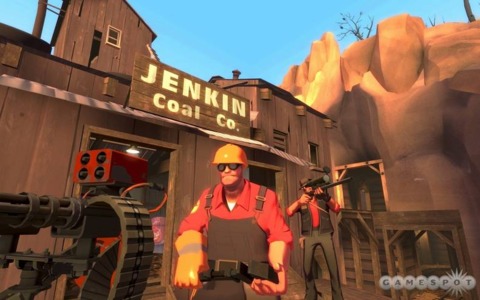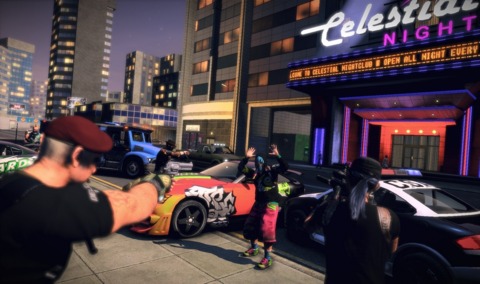Free for All: Why Both a Success and a Failure Went Free
How can Team Fortress 2 and APB have anything in common? A story about a hat-based business.
What does an immensely popular first-person shooter from 2007 have in common with one of 2010's biggest failures? The gameplay, setting, and genre of Valve's Team Fortress 2 are a stark contrast to Realtime Worlds' APB. What they do share is an economy entirely based on selling goofy hats, powerful guns, and strange items. These two very different games started at full retail price but have since become free games supported by cash shops. So how can two games head down divergent paths but lead to the same result? During GDC 2012 we went to two lectures within hours of each other and learned why both games went free-to-play.
For most games, switching from a paid business model to a model based on handing out free copies and solely monetized through cash shops is a sign of desperation. Such was the case with APB, the Realtime Worlds-developed massive multiplayer third-person shooter. Issues with the gameplay and a lack of focus hindered the game's popularity and revenue. Just four months after APB's 2010 release, Realtime Worlds was out of business, the servers were shut down, and all game properties were sold off to K2 Networks.
The original development of ABP sans marketing cost over $70 million, while K2 Networks acquired the game for a mere $5 million. To further help K2 reestablish the game as its own, new development is being handled by the company's in-house studio Reloaded Productions, and the game has been rebranded as APB: Reloaded. K2 hopes to earn $60 million minus upkeep by using its free business model. While going free as APB has is the typical story of recovering from failure, Team Fortress 2 became free from its success.
However, it wasn't the new weapons or gameplay changes that started to shift TF2's business model. It was instead something else that came with the Sniper vs. Spy update: the introduction of hats.
TF2 was initially released in October 2007 either as part of The Orange Box or as a stand-alone version on Steam. The game sold well on its release, but numbers steadily decreased with time. There were the standard spikes in revenue each time TF2 went on sale over Steam, but the largest influx of new players came from class updates. The first of these updates was for only a single class: the medic. Three new weapons, achievements, and other changes to the medic class were mainly to entice current players and gain further press coverage. Future class updates were developed by syncing the needs of both new and current players.
Valve achieved its goals by teasing the updates with videos, brochure ads, and comics weeks before the scheduled release. Oftentimes the final design of an update wasn't set in stone, and the developers read forums closely to see what fans wanted or expected. When the sniper's huntsman bow was revealed, players thought it would be cool if the pyro could light the arrow, letting the sniper deal fire damage. Valve hadn't thought of this itself and quickly added the feature in time for the Sniper vs. Spy update. However, it wasn't the new weapons or gameplay changes that started to shift TF2's business model. It was instead something else that came with the Sniper vs. Spy update: the introduction of hats.
Players gained hats at set intervals of time. The first formula for drops required players to accumulate nearly 120 hours of game time on average to obtain even one. Thousands of people were logging into TF2 for dozens of hours a week and gaining no drops. This caused hats to become rare status symbols and prompted rampant cheating to gain as many hats as possible with as little effort as possible. To combat this, Valve changed the algorithm to drop both hats and weapons around every hour and 40 minutes, ensuring around seven items awarded each week. With the huge influx of hats and weapons floating around the game, it made perfect sense to shift the game to free-to-play and open an in-game shop.
K2 Networks recognizes Valve's success with turning Team Fortress 2 free-to-play, but isn't looking to copy its methods. K2 already has experience with successful free-to-play games, such as Korean-developed War Rock and Sword of the New World: Granado Espada. In fact, it has been at this so long that within the United States K2 has trademarked the term "Free2Play." Foremost, what succeeded in a first-person shooter isn't going to fully work for a massively multiplayer online game. Reloaded Productions is doing what it can to create new appealing content for its fan base, but some of APB's problems are deep rooted within the core game, and changes will take time.
Problems first arose from lack of environmental controls. Maps in ABP are made procedurally, making it difficult to tweak sniper spots, choke points, and other strategic locations. If the designers wanted to move a building even a few centimeters, the whole map would need to be scrapped and remade. Oftentimes these maps would also have a lack of signposts guiding players toward key locations. This initially left players lost and confused after clearing the tutorial. As a result, a steep number of users wound up quitting after the first 10 levels of gameplay.
K2 Networks found that those who won their first match in APB: Reloaded were 30 percent more likely to use the cash shop.
Another big hurdle for Reloaded was fixing APB's mission system. Changes were made to make losing or quitting a mission less frustrating. This was done by reducing penalties from abandoning missions and making it faster to lose an uphill battle. Matchmaking was also overhauled to make sure players of equal skill levels and equipment are pitted against each other. Players are further distributed on a skill curve and are ranked to help place them in matches they are more likely to win. Even something as slight as not showing the enemy's threat level greatly alters a player's perception of difficulty and balance.
The game fixes are the first step if APB hopes to succeed. Players will only spend money on a game they're invested in. K2 Networks found that those who won their first match in APB: Reloaded were 30 percent more likely to use the cash shop. It should be easy for K2 to fill its shop with an array of clothes, cars, and weapons. APB has a plethora of editors to design the look of characters and their gear, and even a full music editor to make custom death tunes. However, the main concern is to not introduce items that imbalance the game.
Both K2 Networks and Valve know that players should never have to pay to win or even perceive that it's possible to do so. Every new item--whether it's a fancy new car or a knife that steals identities--needs to be a side grade rather than a straight upgrade. If a gun from the cash shop has high damage, it needs some kind of counterbalance to not outclass other weapons players could find for free. Where the two companies disagreed was just how consumers should be able to purchase these new items.
Using Steam, Valve lets users pay with common local currencies, such as US dollars, pounds, and rubles. They feel that this encourages users to spend more because there is no conversion rate nor will customers be stuck with small remainders of an online currency. K2 is more traditional, requiring players to use G1 Credits on its GamersFirst website. The G1 is designed to be usable with any of K2's games featured on GamersFirst and can sometimes be obtained from free promotions. It's not just a matter of how players are paying for items but, in some cases, how they are trading with others.
Team Fortress 2's in-game store has pioneered Steam trading that lets users exchange items from TF2, Portal 2, and Three Rings Design's Spiral Knights with one another. Steam users can even trade games that they have received as gifts on Steam. Not only is this a quick system, but it reduces the risk of third-party item sales. K2 Networks could easily learn something from this model. In fact, APB: Reloaded has already hit Steam's free-to-play section, and we feel that it could prosper by integrating Steam trading. Still, K2 doesn't seem to be keen on supporting a system other than the G1 Credit and GamersFirst site.
The overall key to success as a paid game gone free might lie in stigmas and consumers' expectations. Team Fortress 2 had a huge advantage right out of the gate. It was a sequel to an incredibly popular first-person shooter developed by a company with a near-flawless track record. APB may have been first developed by the successful Realtime Worlds, but it was venturing into a completely different genre with a brand-new intellectual property. Because the game bombed once, many are wary of investing time or money in APB: Reloaded. It's rather simple: make a fun game first. Team Fortress 2 was able to stand on its own worth, strong enough to support a free business model. APB: Reloaded is dependent on free-to-play for its very survival.
Got a news tip or want to contact us directly? Email news@gamespot.com



Join the conversation